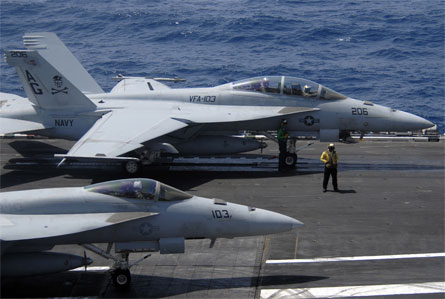Boeing will build another 124 F/A-18E/F Super Hornets and EA-18G Growlers through at least 2013 under a $5.3 billion, four-year deal signed on 28 September by the US Navy.
The contract signing comes more than four months after both sides resolved a pricing dispute and ensures that Boeing will remain in the fighter business for the next four years as it pursues additional new orders on the foreign market.
Since 2000, Boeing had received two multi-year contracts to build nearly 500 Super Hornets and Growlers. Such multi-year procurements (MYP) are expected to reduce manufacturing costs by lowering the risk for suppliers to make long-term investments in efficiency improvements.
 |
|---|
© US Navy |
The new deal will safeguard domestic Super Hornet through 2013 |
Secretary of Defense Robert Gates complained earlier this year that Boeing had offered cost savings of only 7%, which fell short of the Department of Defense's 10% minimum for approving multi-year awards.
Both sides reached agreement on the $5.3 billion amount, or $42.7 million per aircraft. This sum is about 10% lower than the inflation-adjusted price for the Super Hornet in the previous multi-year buy, and more than 13% lower than the initial MYP contract signed 10 years ago.
Boeing needs to keep the Super Hornet production line going for several years to compete for foreign orders. The company is currently offering the Super Hornet to Brazil, India and Japan.
The Royal Australian Air Force has already ordered 24 two-seat F/A-18F to replace its General Dynamics F-111s, the last of which will be retired on 2 December. Its Block II Super Hornets will also provide a stopgap until the service's introduction of the Lockheed Martin F-35 Joint Strike Fighter.
Boeing has meanwhile completed production activities on the RAAF's first of 12 Super Hornets that could later be configured to conduct electronic attack missions.
Australia has now received 11 aircraft under its Super Hornet programme, with the remainder to be delivered to Amberley air base in Queensland through 2011.
Source: Flight International



















